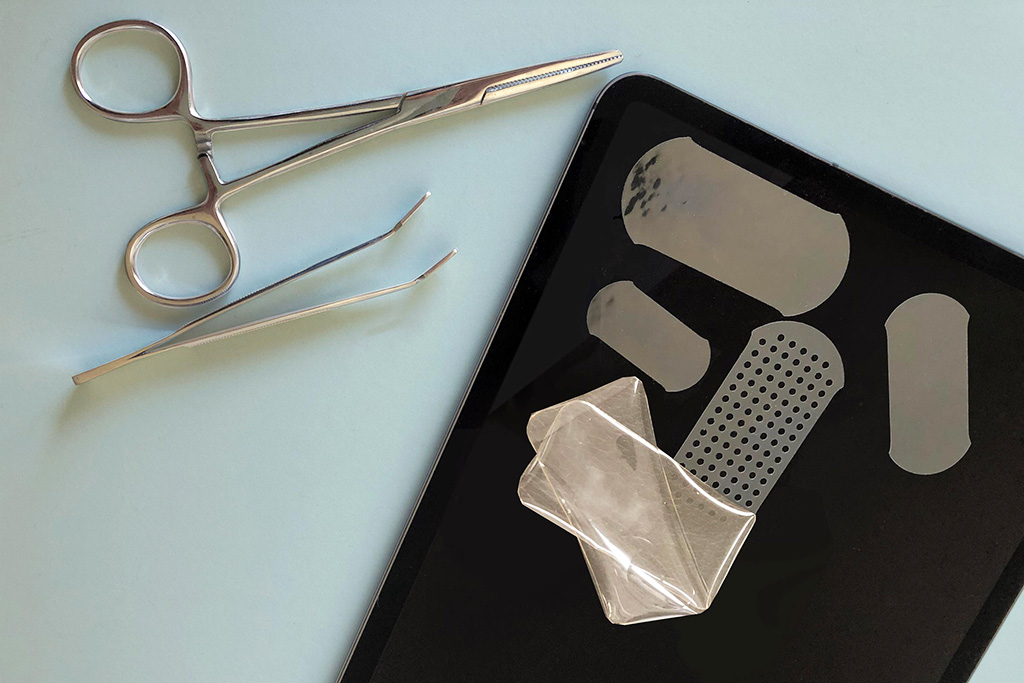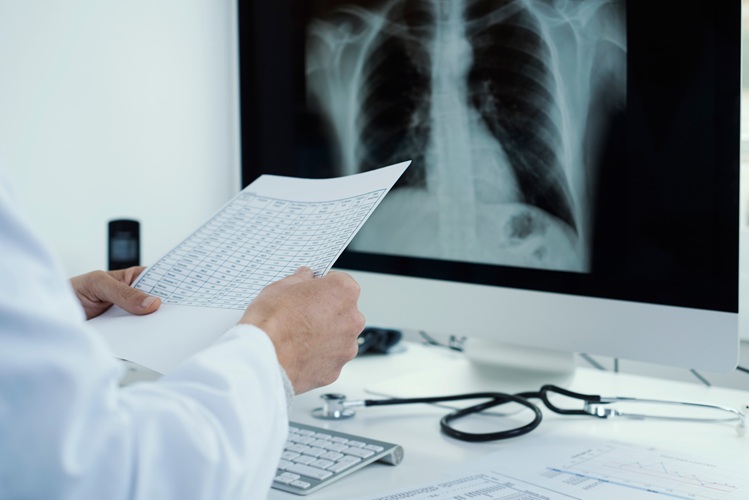Double-Sided Adhesive Could Replace Surgical Sutures
|
By HospiMedica International staff writers Posted on 18 Nov 2019 |

Image: A double-sided adhesive can be used to seal tissues together (Photo courtesy of Felice Frankel/MIT)
A novel double-sided tape (DST) that can seal tissues in just five seconds could eventually be used to replace sutures, claims a new study.
Researchers at the Massachusetts Institute of Technology (MIT, Cambridge, MA, USA), Harvard Medical School (HMS; Boston, MA, USA), and other institutions made the dry DST by combining a biopolymer (gelatin or chitosan) and a crosslinked polyacrylic acid grafted with N-hydrosuccinimide ester. The polyacrylic acid first absorbs water from wet tissues, forming weak hydrogen bonds and other weak interactions that temporarily hold both DTS and tissues together. The embedded NHS esters in the polyacrylic acid then form much stronger covalent bonds with proteins in the tissue, a process that takes about five seconds.
In mouse and rat models, the researchers showed that the DST can achieve strong adhesion between diverse wet dynamic tissues, such as the skin, small intestine, stomach, and liver. They also performed tests in pig lungs and trachea, which showed that they could rapidly repair damage to those organs. The researchers added that depending on the application the DST is being used for, its dissolution rate can be controlled by varying the ingredients. While gelatin tends to break down within a few days or weeks in the human body, chitosan can last up to a year. The study was published on October 30, 2019, in Nature.
“There are over 230 million major surgeries all around the world per year, and many of them require sutures to close the wound, which can actually cause stress on the tissues and can cause infections, pain, and scars,” said senior author MIT associate professor Xuanhe Zhao, PhD. “We are proposing a fundamentally different approach to sealing tissue. The tape could eventually replace surgical sutures, which don’t work well in all tissues and can cause complications in some patients.”
Two dry surfaces can instantly adhere upon contact with each other through intermolecular forces such as hydrogen bonds, electrostatic interactions, and van der Waals interactions. However, such instant adhesion is challenging when wet surfaces such as body tissues are involved, because water separates the molecules of the two surfaces, preventing interactions. In addition, existing liquid or hydrogel tissue adhesives suffer from several limitations, such as weak bonding, low biological compatibility, poor mechanical match with tissues, and slow adhesion formation.
Related Links:
Massachusetts Institute of Technology
Harvard Medical School
Researchers at the Massachusetts Institute of Technology (MIT, Cambridge, MA, USA), Harvard Medical School (HMS; Boston, MA, USA), and other institutions made the dry DST by combining a biopolymer (gelatin or chitosan) and a crosslinked polyacrylic acid grafted with N-hydrosuccinimide ester. The polyacrylic acid first absorbs water from wet tissues, forming weak hydrogen bonds and other weak interactions that temporarily hold both DTS and tissues together. The embedded NHS esters in the polyacrylic acid then form much stronger covalent bonds with proteins in the tissue, a process that takes about five seconds.
In mouse and rat models, the researchers showed that the DST can achieve strong adhesion between diverse wet dynamic tissues, such as the skin, small intestine, stomach, and liver. They also performed tests in pig lungs and trachea, which showed that they could rapidly repair damage to those organs. The researchers added that depending on the application the DST is being used for, its dissolution rate can be controlled by varying the ingredients. While gelatin tends to break down within a few days or weeks in the human body, chitosan can last up to a year. The study was published on October 30, 2019, in Nature.
“There are over 230 million major surgeries all around the world per year, and many of them require sutures to close the wound, which can actually cause stress on the tissues and can cause infections, pain, and scars,” said senior author MIT associate professor Xuanhe Zhao, PhD. “We are proposing a fundamentally different approach to sealing tissue. The tape could eventually replace surgical sutures, which don’t work well in all tissues and can cause complications in some patients.”
Two dry surfaces can instantly adhere upon contact with each other through intermolecular forces such as hydrogen bonds, electrostatic interactions, and van der Waals interactions. However, such instant adhesion is challenging when wet surfaces such as body tissues are involved, because water separates the molecules of the two surfaces, preventing interactions. In addition, existing liquid or hydrogel tissue adhesives suffer from several limitations, such as weak bonding, low biological compatibility, poor mechanical match with tissues, and slow adhesion formation.
Related Links:
Massachusetts Institute of Technology
Harvard Medical School
Latest Surgical Techniques News
- DNA Origami Improves Imaging of Dense Pancreatic Tissue for Cancer Detection and Treatment
- Pioneering Sutureless Coronary Bypass Technology to Eliminate Open-Chest Procedures
- Intravascular Imaging for Guiding Stent Implantation Ensures Safer Stenting Procedures
- World's First AI Surgical Guidance Platform Allows Surgeons to Measure Success in Real-Time
- AI-Generated Synthetic Scarred Hearts Aid Atrial Fibrillation Treatment
- New Class of Bioadhesives to Connect Human Tissues to Long-Term Medical Implants
- New Transcatheter Valve Found Safe and Effective for Treating Aortic Regurgitation
- Minimally Invasive Valve Repair Reduces Hospitalizations in Severe Tricuspid Regurgitation Patients
- Tiny Robotic Tools Powered by Magnetic Fields to Enable Minimally Invasive Brain Surgery
- Magnetic Tweezers Make Robotic Surgery Safer and More Precise
- AI-Powered Surgical Planning Tool Improves Pre-Op Planning
- Novel Sensing System Restores Missing Sense of Touch in Minimally Invasive Surgery
- Headset-Based AR Navigation System Improves EVD Placement
- Higher Electrode Density Improves Epilepsy Surgery by Pinpointing Where Seizures Begin
- Open-Source Tool Optimizes Placement of Visual Brain Implants
- Easy-To-Apply Gel Could Prevent Formation of Post-Surgical Abdominal Adhesions
Channels
Critical Care
view channel
Smart Bandage Monitors Chronic Wounds in Human Patients
A future smart bandage, envisioned as a "lab on skin," could assist both patients and caregivers by not only monitoring chronic wounds but also delivering treatment and accelerating the healing process... Read more
AI Identifies Patients with Increased Lung Cancer Risk Up To 4 Months Earlier
Earlier diagnosis plays a crucial role in improving the prognosis of cancer, as delays in starting therapy are associated with decreased survival rates. In most cases, cancer is first identified when symptoms... Read more
AI Algorithm Identifies High-Risk Heart Patients
Hypertrophic cardiomyopathy (HCM) is a complex condition characterized by the thickening of the heart muscle, which impairs the heart's ability to pump blood effectively. This forces the heart to work... Read more
Next Gen Hemodynamic Monitoring Solution Provides AI-Driven Clinical Decision Support
A new cutting-edge hemodynamic monitoring platform, equipped with predictive artificial intelligence (AI)-based algorithms, is designed to help clinicians proactively manage blood pressure fluctuations... Read morePatient Care
view channel
Portable Biosensor Platform to Reduce Hospital-Acquired Infections
Approximately 4 million patients in the European Union acquire healthcare-associated infections (HAIs) or nosocomial infections each year, with around 37,000 deaths directly resulting from these infections,... Read moreFirst-Of-Its-Kind Portable Germicidal Light Technology Disinfects High-Touch Clinical Surfaces in Seconds
Reducing healthcare-acquired infections (HAIs) remains a pressing issue within global healthcare systems. In the United States alone, 1.7 million patients contract HAIs annually, leading to approximately... Read more
Surgical Capacity Optimization Solution Helps Hospitals Boost OR Utilization
An innovative solution has the capability to transform surgical capacity utilization by targeting the root cause of surgical block time inefficiencies. Fujitsu Limited’s (Tokyo, Japan) Surgical Capacity... Read more
Game-Changing Innovation in Surgical Instrument Sterilization Significantly Improves OR Throughput
A groundbreaking innovation enables hospitals to significantly improve instrument processing time and throughput in operating rooms (ORs) and sterile processing departments. Turbett Surgical, Inc.... Read moreHealth IT
view channel
Printable Molecule-Selective Nanoparticles Enable Mass Production of Wearable Biosensors
The future of medicine is likely to focus on the personalization of healthcare—understanding exactly what an individual requires and delivering the appropriate combination of nutrients, metabolites, and... Read more
Smartwatches Could Detect Congestive Heart Failure
Diagnosing congestive heart failure (CHF) typically requires expensive and time-consuming imaging techniques like echocardiography, also known as cardiac ultrasound. Previously, detecting CHF by analyzing... Read moreBusiness
view channel
Expanded Collaboration to Transform OR Technology Through AI and Automation
The expansion of an existing collaboration between three leading companies aims to develop artificial intelligence (AI)-driven solutions for smart operating rooms with sophisticated monitoring and automation.... Read more















